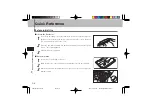
Sound Parameters – Oscillators
Waldorf Q User’s Manual
66
Oscillators
The Waldorf Q is equipped with three oscillators that have almost the same functionality.
Oscillator Shapes
The oscillator is the first building block of a synthesizer. It delivers the signal that is transformed by all
other components of the synthesizer. In the early days of electronic synthesis, Robert A. Moog found
out that most real acoustic instrument waveforms could be reproduced by using abstracted electronic
versions of these waveforms. He wasn’t the first who came to that conclusion but he was the first in
recreating them electronically and building them into a machine that could be used commercially.
What he implemented into his synthesizer were the still well-known waveforms sawtooth, square and
triangle. For sure, this is only a minimal selection of the endless variety of waveforms, but the Waldorf
Q gives you exactly these waveforms at hand. Plus other classic waveforms like pulse (which is the
father of the square waveform) and the sine wave (which is also part of each other waveform).
Now, you probably know how these waveforms look and sound like, but the following chapter gives
you a small introduction into the deeper structure of these waveforms. Let’s start with the most basic
one.
The Sine Wave
The Sine Wave is the purest tone that can be generated. It consists only of one harmonic, the
fundamental, and has no overtones. The following picture shows the sine wave and its frequency
representation:
1
4
8
12
16
Frequency
Magnitude
Time
Amplitude
Harmonics
The Sine Wave
There is no acoustic music instrument that generates a pure sine wave, the only instrument that comes
close to it is the pitch fork. Therefore, the sine wave sounds a little artificial to the ear. However, the
sine wave can be an interesting oscillator waveform to emphasize a certain harmonic while other
oscillators are playing more complex waveforms, or as fm source for frequency modulation.
The sine wave is the most basic building block of each waveform. Any waveform can be broken
down to several or many sine waves that are arranged with different frequencies and magnitudes.
These sine waves are called
partials
. In most waveforms, the partial with the lowest frequency is
dominant, meaning that this partial is used by the ear to determine the pitch of the tone. This partial is
called
fundamental
. All other partials are called
overtones
. So, the second partial is the first overtone.
Cyclic waveforms such as the waveforms in the Q only feature sine waves in integer frequency ratios
to the fundamental like double frequency, triple frequency and so on. Those partials are called
harmonics
because their frequency is a harmonic multiple of the fundamental.
Confusing? Let’s generalize it to cyclic waveforms: a cyclic waveform like sawtooth, square etc. only
consists of harmonic partials. The harmonic with the lowest frequency is dominant and therefore
called fundamental. All other harmonics are called overtones.
Summary of Contents for Q Rack
Page 1: ...User s Manual Q Keyboard Q Rack ...
Page 170: ...Appendix MIDI Implementation Chart Waldorf Q User s Manual 170 ...
Page 172: ......
Page 173: ......
















































